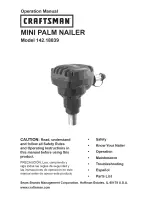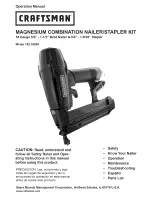
3 - English
Know your pneumatic tool.
Read operator’s manual
carefully. Learn its applications and limitations, as well
as the specific potential hazards related to this tool.
Following this rule will reduce the risk of electric shock,
fire, or serious injury.
Always wear eye protection with side shields marked
to comply with ANSI Z87.1 along with hearing and
head protection.
Failure to do so could result in objects
being thrown into your eyes and other possible serious
injuries.
Protect your lungs.
Wear a face or dust mask if the
operation is dusty. Following this rule will reduce the risk
of serious personal injury.
Protect your hearing.
Wear hearing protection during
extended periods of operation. Following this rule will
reduce the risk of serious personal injury.
Make sure the hose is free of obstructions or snags.
Entangled or snarled hoses can cause loss of balance or
footing and may become damaged.
Use the tool only for its intended use.
Do not discharge
fasteners into open air.
Use the pneumatic tool only for the purpose for which
it was designed.
Use only the fasteners recommended for this tool.
Use of the wrong fasteners could result in poor fastener
feeding, jammed fasteners, and nails leaving the tool at
erratic angles. If fasteners are not feeding smoothly and
properly, discontinue their use immediately. Jammed
and improperly feeding fasteners could result in serious
personal injury.
Never use this tool in a manner that could cause a
fastener to be directed toward anything other than
the workpiece.
Do not use the tool as a hammer.
Always carry the tool by the handle.
Never carry the
tool by the air hose.
Do not alter or modify this tool from the original design
or function without approval from the manufacturer.
Always be aware that misuse and improper handling
of this tool can cause injury to yourself and others.
Never clamp or tape the trigger or workpiece contact
in an actuated position.
Never leave a tool unattended with the air hose
attached.
Do not operate this tool if it does not contain a legible
warning label.
Do not continue to use a tool that leaks air or does
not function properly.
OPERATION
Always assume that the tool contains fasteners.
Do not carry the tool from place to place holding the
trigger.
Accidental discharge could result.
Always handle the tool with care:
• Respect the tool as a working implement.
• Never engage in horseplay.
• Never pull the trigger unless nose is directed toward
the work.
• Keep others a safe distance from the tool while tool is in
operation as accidental actuation may occur, possibly
causing injury.
Choice of triggering method is important. Check
manual for triggering options.
Pneumatic tools are designed for single-hand use.
Do
not hold the tool by the front of the magazine. Do not put
hands, head, or other parts of your body near the bottom
of the magazine where the nail exits the tool, as serious
personal injury could result.
Do not point the tool toward yourself or anyone
whether it contains fasteners or not.
Do not actuate the tool unless you intend to drive a
fastener into the workpiece.
Always ensure that the workpiece contact is fully
positioned on the workpiece.
Positioning the work
contact element only partially on the workpiece could
cause the fastener to miss the workpiece completely and
result in serious personal injury.
Do not drive fasteners near edge of material.
The
workpiece may split causing the fastener to ricochet,
injuring you or a co-worker. Be aware that the nail or
fastener may follow the grain of the wood, causing it to
protrude unexpectedly from the side of the work material.
Keep hands and body parts clear of immediate work
area.
Hold workpiece with clamps when necessary to
keep hands and body out of potential harm. Be sure the
workpiece is properly secured before pressing the nailer
against the material. The workpiece contact may cause
the work material to shift unexpectedly.
Keep face and body parts away from back of the tool
cap when working in restricted areas.
Sudden recoil
can result in impact to the body, especially when nailing
into hard or dense material.
SPECIFIC SAFETY RULES
Summary of Contents for YG200BN
Page 34: ...14 NOTES NOTAS...
Page 35: ...15 NOTES NOTAS...




































